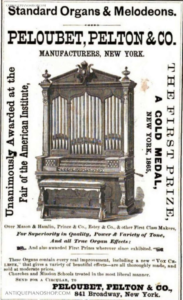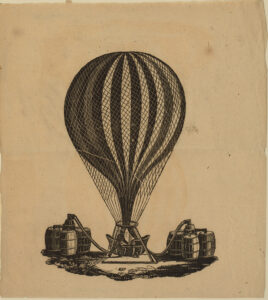While researching the Albany Bicentennial tablets, we tripped on the most curious little snippet in Joel Munsell’s Annals of Albany, in an article dated April 26, 1819:
“A Mr. Peloubet gave notice that he would ascend in a balloon from the Capitol. The expenses he would attempt to raise by collection from the audience before the ascension. He apologized two days after that in consequence of the high wind the balloon did not rise with sufficient rapidity to get out of the reach of the boys, one of whom threw a stone which penetrated the balloon and brought it to the earth. But he would send up a small and a large one on Wednesday the 28th.”
Munsell never mentions him again. And we haven’t found another thing that would connect Mr. Peloubet with ballooning. But about Mr. Peloubet himself, we found plenty.

Based on the 1819 date, it appears we’re talking about Joseph Alexander de Chabrier de Peloubet. Born in 1764 in the Chateau de Peloubet, near Lauzun, France, his name was originally Louis Alexander. He served a life at sea as supercargo, an officer on merchant ships who manages the cargo owner’s trade, traveling largely to the West Indies – and given France’s active and unique participation in the slave trade until 1794, there’s a likelihood that some of that “cargo” was human slaves. (Look up the French Atlantic Triangle for more information on how France shipped slaves from Africa to the Caribbean to create product for France).
At the time of the French revolution, Peloubet returned to France and took the side of King Louis XVI, serving in the royal army near Germany until the King lost his head, his unit disbanded, and Peloubet escaped into Germany. At some point he thought it safe to return home, but he was wrong. He was arrested, tried, and sentenced to execution. However, some unknown party arranged his escape, and he made his way back to Germany. It was there that he learned the making of musical instruments, beginning with flute, fife, and clarinet – woodwinds.
With a Napoleonic decree that reversed the sentences of the Republican courts, Peloubet’s head was no longer at risk in France, and he was charged with settling a family estate on what was then the Isle of Bourbon (now Reunion), French-held territory in the Indian Ocean. Sailing there was complicated by war, and apparently it would be easiest to sail there from the United States, so he landed in New York in 1803. The Isle of Bourbon fortunes apparently evaporated, and he turned to supporting himself in New York through making woodwinds. It was there that he changed his name to Joseph, and went into partnership with another French refugee, establishing the firm of Monniot and Peloubet, building woodwinds, pianofortes, and harpsichords on lower Broadway in New York City.

At 41, he met and married 20-year-old Elizabeth Alcott, originally of Athens, NY, in 1805. “He could never speak much English, and she knew next to nothing of French, but they mutually understood each other….” Together they had 11 children, the youngest born when Peloubet was 71, and they lived all over the place through the years – Philadelphia, New York, Athens, Albany, Hudson and Catskill, and, late in life, the New Jersey communities of Orange and Bloomfield. Joseph died in Bloomfield in 1844, at 80; Elizabeth lived another ten years, and both are buried in Bloomfield.
It’s worth noting that son Louis Michel Francois Peloubet, known as Chabrier Peloubet, also took up instrument making, moving his workshop to Bloomfield in 1836, building melodeons about 1842 and moving to cabinet organs around 1848. The company went by various names over the years, finally being sold to Chicago’s Lyon & Healy in 1890.
We didn’t find any formal records of Peloubet’s presence in Albany. One genealogy puts him in Albany in 1810, Athens in 1816 and 1819 (when two of his songs were born), and Catskill in 1828 and 1830. That certainly could align with an 1819 visit to the old Capitol. But we also don’t find another single reference to Joseph Peloubet and ballooning.

The first free flight was achieved by two men in 1783 in Paris, in a hot air balloon of paper and silk (or linen, depends on the source) made by (but not carrying) the Montgolfier brothers. The first gas balloon, much more practical in those days, was launched just ten days later. (But “more practical” was relative. Hot air required fire near silk and paper, not the safest of conditions; hydrogen gas was produced by combining sulfuric acid and iron filings.) The first manned flight in America took place Jan. 9, 1793, with a hydrogen balloon piloted by a Frenchman who traveled from Philadelphia to Gloucester County, New Jersey. Ballooning was a national fascination, and it would certainly make sense that someone wanting to demonstrate a balloon flight would do so at a place like the Capitol building of New York. And as a successful instrument builder, Peloubet would easily have had the means to have a balloon constructed. But, to date, beyond the newspaper article that Munsell quoted, we’ve found no other mention that our instrument builder was also a balloon pilot.
